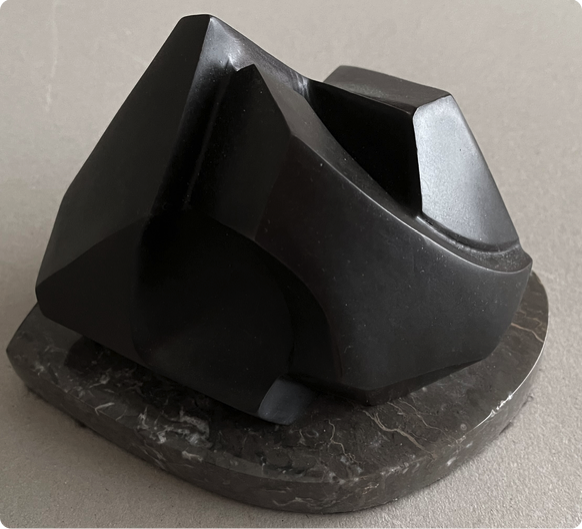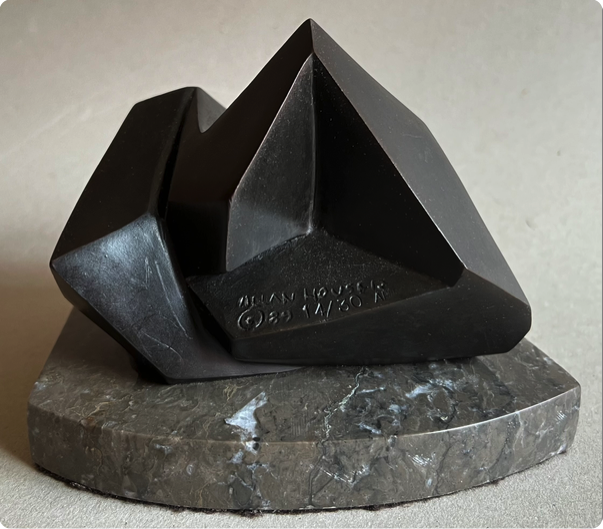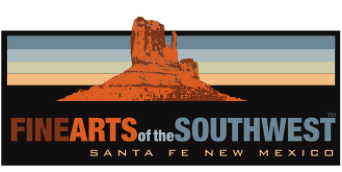
© 2010-2025 by Fine Arts of the Southwest, Inc. All rights reserved.
Unauthorized reproduction or use is strictly prohibited by law.
"Abstract Geometric", an original Chiricahua Apache Modernist bronze and marble sculpture
by Allan Houser, Santa Fe, NM, 1989
Chiricahua Apache Indian artist, Allan Capron Houser (1914-1994) was one of the most renowned
Native American painters and Modernist sculptors of the 20th Century. He is widely considered today to be
the patriarch of American Indian sculpture.
Allan Houser’s tribal heritage is extraordinary, his family is certified Apache Indian royalty and then some. Allan was
the Great-Grandson of the legendary Apache Chief, Mangas Coloradas. His Grandfather was the Chiricahua Apache head chief, Geronimo’s first cousin and close adviser and fought alongside him in the Indian Wars. After the Warm Springs Band of Apaches surrendered in 1897, Allan’s parents, Sam and Blossom Haozous, were imprisoned for the next 23 years by the United States Government at Fort Sill, Oklahoma. When they were released in 1914, Allan was the first Apache child of their band to be born free of captivity. He grew up surrounded by the stories, legends and songs of his great ancestors which became the groundwork and inspiration that subsequently informed and fueled his amazing art.
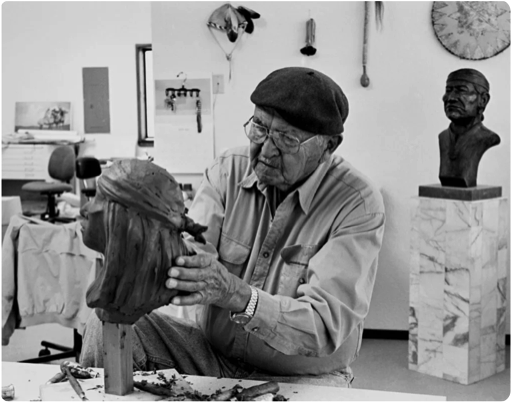
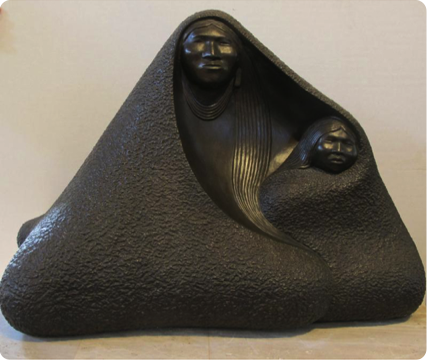
This striking and powerful abstract geometric sculpture bears some very distinct similarities to some of Houser’s other more realistic sculptures of a group of blanket wearing Apache Indians sitting around in a close circle huddled together sharing stories or food or a campfire. This is a visual theme that he returned to regularly; the abstracted forms here evoke this poignant imagery in a beautifully stylized manner. The genius of this particular piece is that it evokes different versions of this imagery as seen from different points of view.
Viewed from one of the scultpure sides at left below it looks like a abstracted stylized version of the Apache Mother
and child as seen above and viewed from another side it looks like two or more people huddled together. And, notably, despite its fairly small size, the sculpture has a distinct and very significant ”monumentality” of feeling and impact to it. When viewed on its own without something to compare it to for scale you wouldn’t really be able to tell if it was five inches, five feet or fifty feet wide!

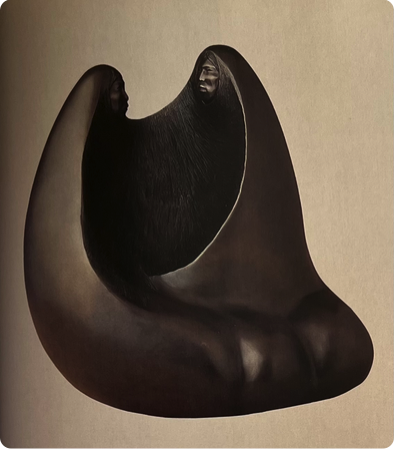
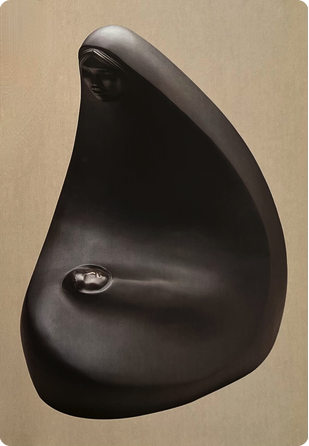
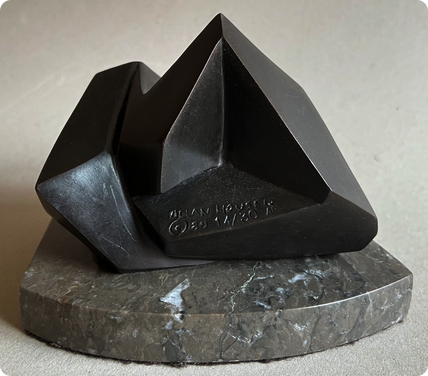
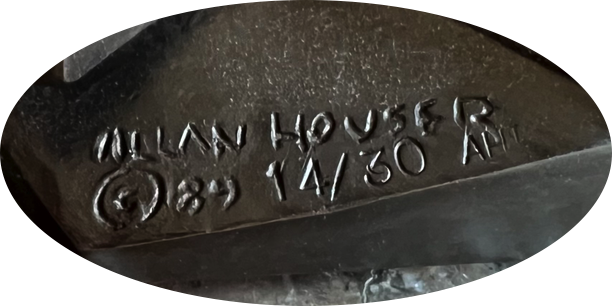

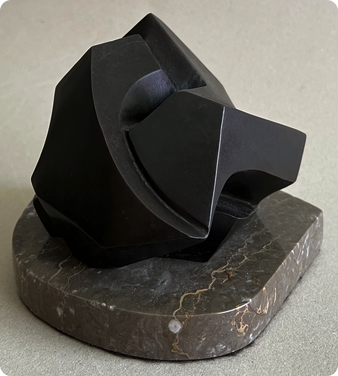
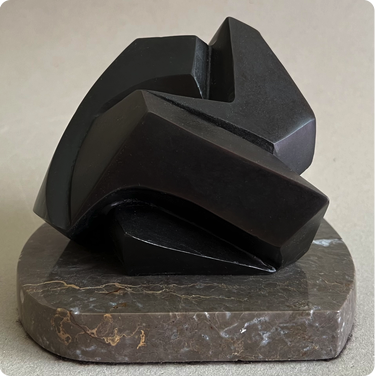
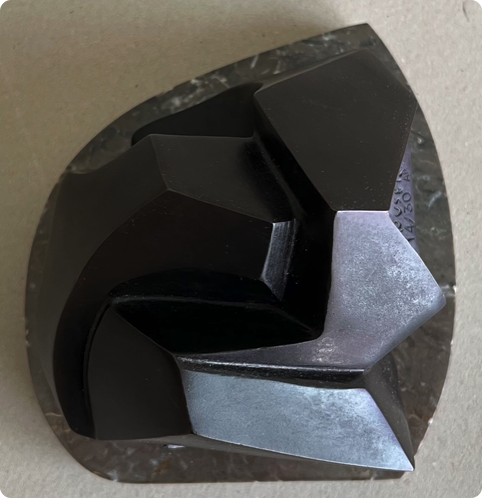

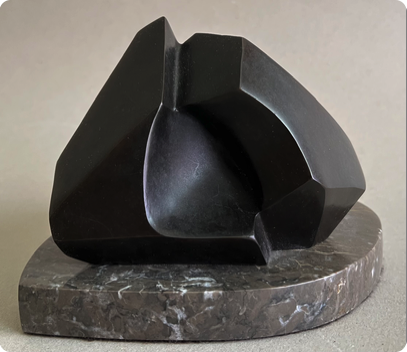
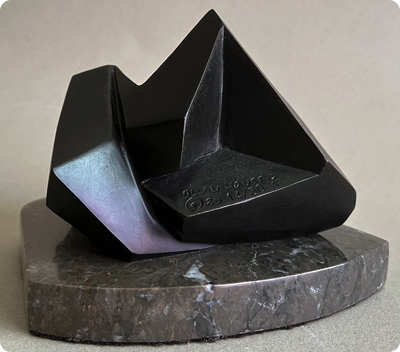
In addition to creating his own many paintings and sculptural works, Allan Houser also taught art full-time for years
at Santa Fe’s Institute for American Indian Arts (IAIA) where he was the head of the Sculpture department from 1962 until he retired from teaching in 1975 to devote himself completely to creating his own art works. The works he produced during this later time period, and particularly during his last five years from 1989-1994, such as this 1989 abstract bronze sculpture, are considered to be the finest and most accomplished of his entire long career. Through his years of teaching and by example through his extraordinary artistic body of work, Houser deeply influenced several generations of Native American artists and paved the way for the acceptance and success of sculpture as an important and significant contemporary Native American art form.*
“Within the studios at IAIA and the ones he built for himself, Houser chipped away at popular conceptions of what sculpture should be. In the process, he transformed Native American art from the parochial to the monumental.”
-Quotation source and © AllanHouser.com
This abstract Modernist bronze piece also owes something to the European abstract sculptural works of Henry Moore, Jean Arp and Constantin Brancusi who sculptures originally inspired Houser to move from painting into sculpture. Houser was uniquely successful at fusing Native American subject matter and sensibility with the abstract forms and sculptural voids of his Modernist peers and in so doing, he carried the mantle of both Native American art and Modernism to new levels.* Houser’s list of artistic awards, accolades and important exhibitions is far too long to mention here, but, importantly, it includes being the first Native American to ever receive the National Medal of Arts, awarded at a ceremony at The White House in 1992 by President George W. Bush.
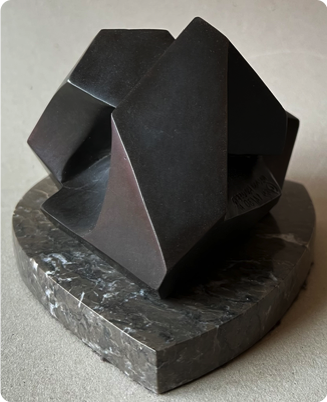
Allan Houser at work in his studio, Santa Fe, NM.
Photo source and © Lee Marmon
Above center, Allan Houser at his compound outside Santa Fe, NM 1991. Below at left, center and right, a selection of several other more realistic sculptures of robed Apache figures by Allan Houser which bear some resemblence to this more abstract modernist piece.
Above center photo source and © "Allan Houser" by W. Jackson Rushing III, Harry Abrams Inc. NY, 2004.
Below photo sources and © "Allan Houser" by W. Jackson Rushing III, Harry Abrams Inc. NY, 2004.
This bronze sculpture is piece Number 14 in a fairly small limited edition of 30 pieces only and the bronze sculpture itself, not including the marble base, measures 5" in length and is 4 3/4" in width and 4" in height. The sculpture together with its beautiful grayish-brown with white accents Italian marble base also hand fashioned by the artist, measures a total of 6 1/2" in length, 5" in width and 5" in height. Both the bronze sculpture and its marble base are in completely excellent original condition and the sculpture is properly signed and numbered by the artist on the lower side in an engraved signature as follows:
"Allan Houser
© 89 14/30 AHI"
This sculpture also has an extremely excellent provenance. We purchased it from the Santa Fe family of its original owner who purchased it new from the Allan Houser family gallery in Santa Fe in the 1990’s. This is an iconic and masterful Modernist sculptural piece from an iconic and masterful Native American artist, who is one of the genuine all-time greatest Masters in the field. It’s a piece to admire and treasure with a great amount of pleasure and pride.
Price $5,900
Note: Some content presented here has been drawn from Wikipedia and Allanhouser.com
